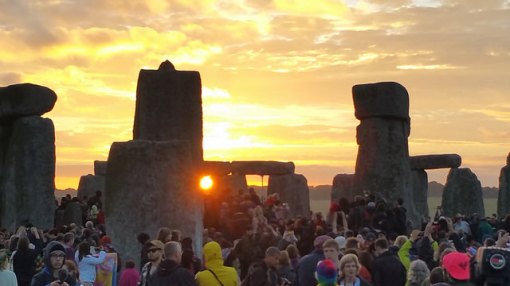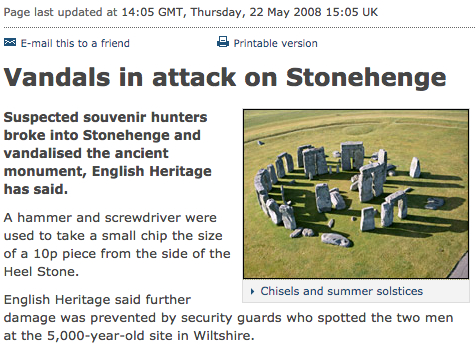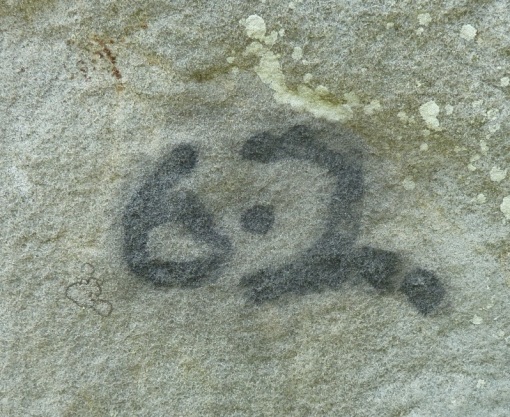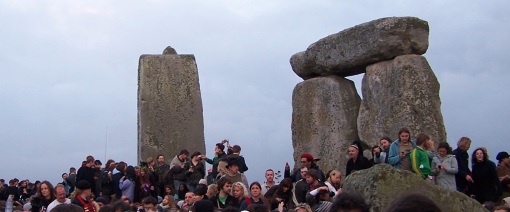Respecting the Stones
The conditions of entry for the Managed Open Access events at the Solstices and Equinoxes contain the following statements:
Stonehenge is a world renowned historic Monument and part of a World Heritage Site. It is seen by many who attend as a sacred place. Please respect it and please respect each other.
Do not climb or stand on any of the stones – this includes the stones that have fallen. This is in the interest of personal safety, the protection of this special site and respect for those attending. As well as putting the stones themselves at risk, climbing on them can damage the delicate lichens.
… but some people seem happy to ignore these requests. I’m going to take a little time to explain that, strange as it may seem, the monument is actually quite delicate and damage to it does occur.

The popularity of the summer solstice has grown over the years
In 1953 during an archaeological investigation a set of carvings were noticed on the inner face of one of the stones of the central trilithons (Stone 53, to be precise). These carvings weren’t the usual graffiti that’ve been incised into many of the stones over the last 200 years or so – people’s names, initials, dates and so on. They were in fact very ancient indeed, dating back to the middle Bronze Age around 1700BC and were of bronze axe heads and a dagger.
Here’s a photo from 1953 showing the ancient carvings, followed by a more recent one:


The ancient carvings are noticeably “softer” around the edges in the modern shot and this is largely due to the action of people’s fingers tracing their outlines over the course of the last 63 years. Sarsen may be hard, but it’s still a sandstone.
Some bluestones exist only as stumps and many are fallen. These get trampled over by thousands of feet at the solstices and equinoxes, and many have acquired a polish as a result.
One of two examples of bluestone are so soft that they crumble away at a touch and these have eroded down to stumps that barely break the surface of the ground.
It’s been a while since tourists were rented hammers by the local blacksmith so they could take souvenirs, but it’s not unknown even in modern times for people to try it.

Although deliberate damage is rare, it does happen. At the 2014 Summer Solstice, someone thought it’d be a good idea to start writing the date (in US format – 6.21.14) in letters about 3” high, using a marker pen, near the bottom of Stone 3.

This damage is permanent. The ink has been carried deep into the stone surface and the conservators have been unable to remove it.
At the winter solstice that year, another bright spark decided to annoint the sides of about a dozen stones with some kind of oil, leaving dark streaks over 18” long that will take decades to fade. If you’re going to annoint the stones with anything, then use pure spring water and not some nasty goo you’ve bought off eBay.
Thoughtless damage happens every year – candlewax from spilt tealights, rubbings with crayon that goes through the paper, forcing random items like crystals or coins into crevices, digging in the ground and even trying to light a fire on a stone.
Disrespectful damage – vomiting, urinating or even defecating on the stones – is less common but also occurs. It’s hard to imagine the kind of person who thinks that sort of behaviour is acceptable anywhere, let alone at our most famous ancient monument.

While standing on the stones is bad enough, climbing up them is far worse.
The fuzzy grey-green lichen that coats the upper reaches of most of the sarsen stones is a species called Sea Ivory (Ramalina Siliquosa) and usually only grows on marine cliffs, particularly in southwest England and Wales. It’s very easily knocked off by people brushing against the stones and large areas are destroyed by someone sliding back down having scaled any of the uprights.
There are at least 9 marine cliff species of lichen present, and how they ended up 50km from the sea is something of a mystery.
The last major study of the Stonehenge lichens was carried out in 2003. It found 77 different species, including two that are found in a particular recess of one specific stone and nowhere else on site, and another that only grows on one single stone at Stonehenge and nowhere else in southern England.
So the next time you decide to come along to an Open Access Equinox or Solstice Dawn, please be one of the people who understands how fragile the monument is and who treats it with respect.
Tell your friends too and – even better – if you find any litter that other people have dropped, please pick it up and put it in one of the bins. Please share this article on social media and help raise awareness.
The stones, the ancestors, and the staff who do the tidying up after you’ve gone home and who genuinely love Stonehenge, all thank you! (This article was submitted with thanks by Simon Banton who worked at the monument for many years)
Stonehenge is protected under the Ancient Monuments and Archaeological Areas Act and you must adhere to the regulations outlined in the act or face criminal prosecution. No person may touch, lean against, stand on or climb the stones, or disturb the ground in any way. The Ancient Monuments Protection Act 1882 was an Act of the Parliament of the United Kingdom of Great Britain and Ireland (as it then was). It was introduced by John Lubbock, 1st Baron Avebury, recognising the need for a governmental administration on the protection of ancient monuments – more information
If you are considering visiting Stonehenge for the Solstice or Equinox celebrations you can join an organised tour. Use a reputable tour operator who respect the conditions. Stonehenge Guided Tours are the longest established company and Solstice Events offer small group Solstice tours using only local expert guides.
The Stonehenge News Blog
Follow us on Twitter and Facebook for all the latest Stonehenge News
http://www.Stonehenge.News














Leave a comment